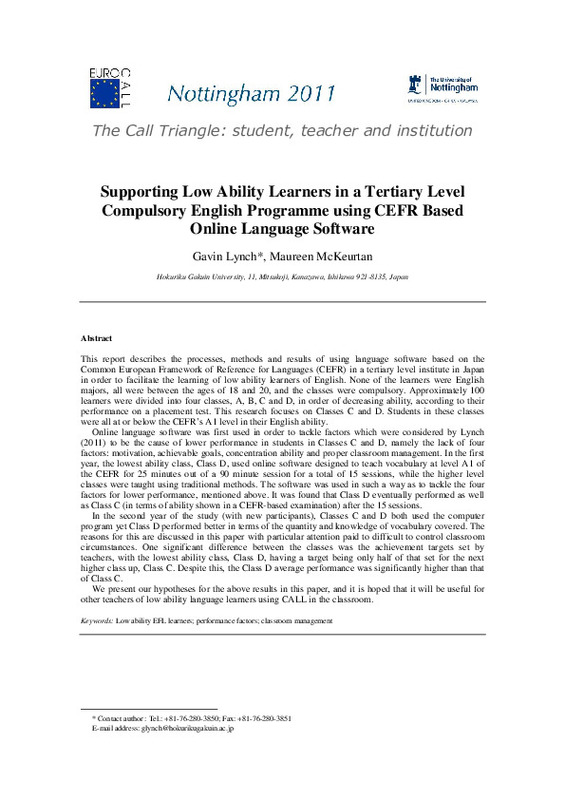JavaScript is disabled for your browser. Some features of this site may not work without it.
Buscar en RiuNet
Listar
Mi cuenta
Estadísticas
Ayuda RiuNet
Admin. UPV
Supporting Low Ability Learners in a Tertiary Level Compulsory English Programme using CEFR Based Online Language Software
Mostrar el registro sencillo del ítem
Ficheros en el ítem
| dc.contributor.author | Lynch, Gavin
|
es_ES |
| dc.contributor.author | McKeurtan, Maureen
|
es_ES |
| dc.date.accessioned | 2023-11-22T11:44:54Z | |
| dc.date.available | 2023-11-22T11:44:54Z | |
| dc.date.issued | 2012-03-22 | |
| dc.identifier.uri | http://hdl.handle.net/10251/200095 | |
| dc.description.abstract | [EN] This report describes the processes, methods and results of using language software based on the Common European Framework of Reference for Languages (CEFR) in a tertiary level institute in Japan in order to facilitate the learning of low ability learners of English. None of the learners were English majors, all were between the ages of 18 and 20, and the classes were compulsory. Approximately 100 learners were divided into four classes, A, B, C and D, in order of decreasing ability, according to their performance on a placement test. This research focuses on Classes C and D. Students in these classes were all at or below the CEFR s A1 level in their English ability. Online language software was first used in order to tackle factors which were considered by Lynch (2011) to be the cause of lower performance in students in Classes C and D, namely the lack of four factors: motivation, achievable goals, concentration ability and proper classroom management. In the first year, the lowest ability class, Class D, used online software designed to teach vocabulary at level A1 of the CEFR for 25 minutes out of a 90 minute session for a total of 15 sessions, while the higher level classes were taught using traditional methods. The software was used in such a way as to tackle the four factors for lower performance, mentioned above. It was found that Class D eventually performed as well as Class C (in terms of ability shown in a CEFR-based examination) after the 15 sessions. In the second year of the study (with new participants), Classes C and D both used the computer program yet Class D performed better in terms of the quantity and knowledge of vocabulary covered. The reasons for this are discussed in this paper with particular attention paid to difficult to control classroom circumstances. One significant difference between the classes was the achievement targets set by teachers, with the lowest ability class, Class D, having a target being only half of that set for the next higher class up, Class C. Despite this, the Class D average performance was significantly higher than that of Class C. We present our hypotheses for the above results in this paper, and it is hoped that it will be useful for other teachers of low ability language learners using CALL in the classroom. | es_ES |
| dc.language | Inglés | es_ES |
| dc.publisher | Universitat Politècnica de València | es_ES |
| dc.relation.ispartof | The EuroCALL Review | es_ES |
| dc.rights | Reconocimiento - No comercial - Sin obra derivada (by-nc-nd) | es_ES |
| dc.subject | Low ability EFL learners | es_ES |
| dc.subject | Performance factors | es_ES |
| dc.subject | Classroom management | es_ES |
| dc.title | Supporting Low Ability Learners in a Tertiary Level Compulsory English Programme using CEFR Based Online Language Software | es_ES |
| dc.type | Artículo | es_ES |
| dc.identifier.doi | 10.4995/eurocall.2012.16201 | |
| dc.rights.accessRights | Abierto | es_ES |
| dc.description.bibliographicCitation | Lynch, G.; Mckeurtan, M. (2012). Supporting Low Ability Learners in a Tertiary Level Compulsory English Programme using CEFR Based Online Language Software. The EuroCALL Review. 20(1):118-120. https://doi.org/10.4995/eurocall.2012.16201 | es_ES |
| dc.description.accrualMethod | OJS | es_ES |
| dc.relation.publisherversion | https://doi.org/10.4995/eurocall.2012.16201 | es_ES |
| dc.description.upvformatpinicio | 118 | es_ES |
| dc.description.upvformatpfin | 120 | es_ES |
| dc.type.version | info:eu-repo/semantics/publishedVersion | es_ES |
| dc.description.volume | 20 | es_ES |
| dc.description.issue | 1 | es_ES |
| dc.identifier.eissn | 1695-2618 | |
| dc.relation.pasarela | OJS\16201 | es_ES |








